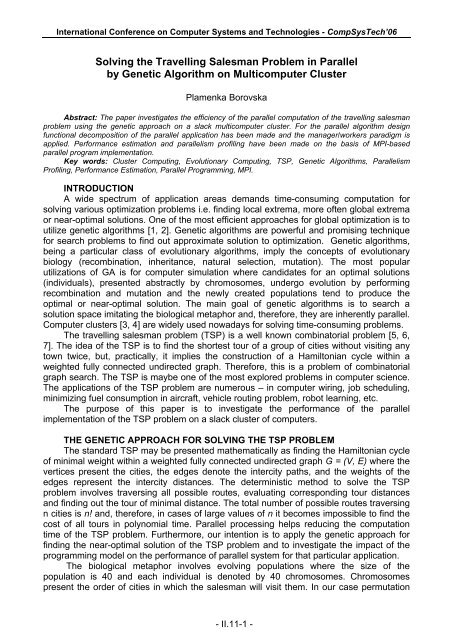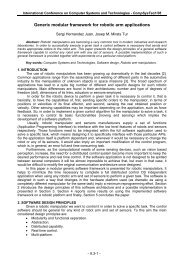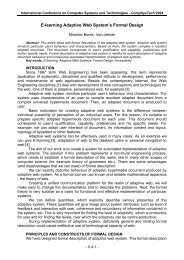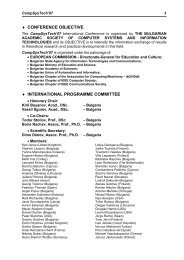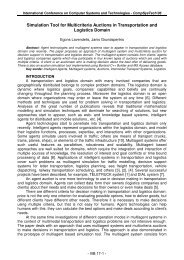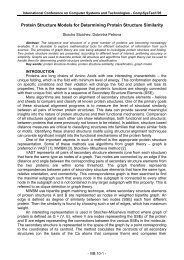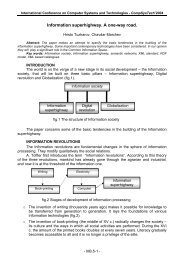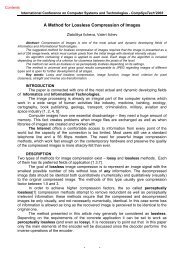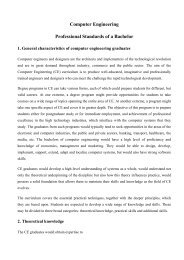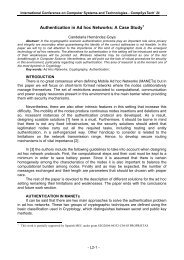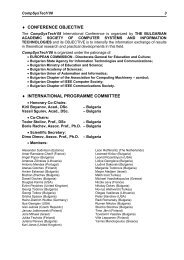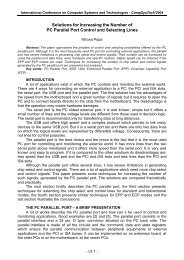Solving the Travelling Salesman Problem in Parallel by ... - Ecet
Solving the Travelling Salesman Problem in Parallel by ... - Ecet
Solving the Travelling Salesman Problem in Parallel by ... - Ecet
You also want an ePaper? Increase the reach of your titles
YUMPU automatically turns print PDFs into web optimized ePapers that Google loves.
International Conference on Computer Systems and Technologies - CompSysTech’06<strong>Solv<strong>in</strong>g</strong> <strong>the</strong> <strong>Travell<strong>in</strong>g</strong> <strong>Salesman</strong> <strong>Problem</strong> <strong>in</strong> <strong>Parallel</strong><strong>by</strong> Genetic Algorithm on Multicomputer ClusterPlamenka BorovskaAbstract: The paper <strong>in</strong>vestigates <strong>the</strong> efficiency of <strong>the</strong> parallel computation of <strong>the</strong> travell<strong>in</strong>g salesmanproblem us<strong>in</strong>g <strong>the</strong> genetic approach on a slack multicomputer cluster. For <strong>the</strong> parallel algorithm designfunctional decomposition of <strong>the</strong> parallel application has been made and <strong>the</strong> manager/workers paradigm isapplied. Performance estimation and parallelism profil<strong>in</strong>g have been made on <strong>the</strong> basis of MPI-basedparallel program implementation.Key words: Cluster Comput<strong>in</strong>g, Evolutionary Comput<strong>in</strong>g, TSP, Genetic Algorithms, <strong>Parallel</strong>ismProfil<strong>in</strong>g, Performance Estimation, <strong>Parallel</strong> Programm<strong>in</strong>g, MPI.INTRODUCTIONA wide spectrum of application areas demands time-consum<strong>in</strong>g computation forsolv<strong>in</strong>g various optimization problems i.e. f<strong>in</strong>d<strong>in</strong>g local extrema, more often global extremaor near-optimal solutions. One of <strong>the</strong> most efficient approaches for global optimization is toutilize genetic algorithms [1, 2]. Genetic algorithms are powerful and promis<strong>in</strong>g techniquefor search problems to f<strong>in</strong>d out approximate solution to optimization. Genetic algorithms,be<strong>in</strong>g a particular class of evolutionary algorithms, imply <strong>the</strong> concepts of evolutionarybiology (recomb<strong>in</strong>ation, <strong>in</strong>heritance, natural selection, mutation). The most popularutilizations of GA is for computer simulation where candidates for an optimal solutions(<strong>in</strong>dividuals), presented abstractly <strong>by</strong> chromosomes, undergo evolution <strong>by</strong> perform<strong>in</strong>grecomb<strong>in</strong>ation and mutation and <strong>the</strong> newly created populations tend to produce <strong>the</strong>optimal or near-optimal solution. The ma<strong>in</strong> goal of genetic algorithms is to search asolution space imitat<strong>in</strong>g <strong>the</strong> biological metaphor and, <strong>the</strong>refore, <strong>the</strong>y are <strong>in</strong>herently parallel.Computer clusters [3, 4] are widely used nowadays for solv<strong>in</strong>g time-consum<strong>in</strong>g problems.The travell<strong>in</strong>g salesman problem (TSP) is a well known comb<strong>in</strong>atorial problem [5, 6,7]. The idea of <strong>the</strong> TSP is to f<strong>in</strong>d <strong>the</strong> shortest tour of a group of cities without visit<strong>in</strong>g anytown twice, but, practically, it implies <strong>the</strong> construction of a Hamiltonian cycle with<strong>in</strong> aweighted fully connected undirected graph. Therefore, this is a problem of comb<strong>in</strong>atorialgraph search. The TSP is maybe one of <strong>the</strong> most explored problems <strong>in</strong> computer science.The applications of <strong>the</strong> TSP problem are numerous – <strong>in</strong> computer wir<strong>in</strong>g, job schedul<strong>in</strong>g,m<strong>in</strong>imiz<strong>in</strong>g fuel consumption <strong>in</strong> aircraft, vehicle rout<strong>in</strong>g problem, robot learn<strong>in</strong>g, etc.The purpose of this paper is to <strong>in</strong>vestigate <strong>the</strong> performance of <strong>the</strong> parallelimplementation of <strong>the</strong> TSP problem on a slack cluster of computers.THE GENETIC APPROACH FOR SOLVING THE TSP PROBLEMThe standard TSP may be presented ma<strong>the</strong>matically as f<strong>in</strong>d<strong>in</strong>g <strong>the</strong> Hamiltonian cycleof m<strong>in</strong>imal weight with<strong>in</strong> a weighted fully connected undirected graph G = (V, E) where <strong>the</strong>vertices present <strong>the</strong> cities, <strong>the</strong> edges denote <strong>the</strong> <strong>in</strong>tercity paths, and <strong>the</strong> weights of <strong>the</strong>edges represent <strong>the</strong> <strong>in</strong>tercity distances. The determ<strong>in</strong>istic method to solve <strong>the</strong> TSPproblem <strong>in</strong>volves travers<strong>in</strong>g all possible routes, evaluat<strong>in</strong>g correspond<strong>in</strong>g tour distancesand f<strong>in</strong>d<strong>in</strong>g out <strong>the</strong> tour of m<strong>in</strong>imal distance. The total number of possible routes travers<strong>in</strong>gn cities is n! and, <strong>the</strong>refore, <strong>in</strong> cases of large values of n it becomes impossible to f<strong>in</strong>d <strong>the</strong>cost of all tours <strong>in</strong> polynomial time. <strong>Parallel</strong> process<strong>in</strong>g helps reduc<strong>in</strong>g <strong>the</strong> computationtime of <strong>the</strong> TSP problem. Fur<strong>the</strong>rmore, our <strong>in</strong>tention is to apply <strong>the</strong> genetic approach forf<strong>in</strong>d<strong>in</strong>g <strong>the</strong> near-optimal solution of <strong>the</strong> TSP problem and to <strong>in</strong>vestigate <strong>the</strong> impact of <strong>the</strong>programm<strong>in</strong>g model on <strong>the</strong> performance of parallel system for that particular application.The biological metaphor <strong>in</strong>volves evolv<strong>in</strong>g populations where <strong>the</strong> size of <strong>the</strong>population is 40 and each <strong>in</strong>dividual is denoted <strong>by</strong> 40 chromosomes. Chromosomespresent <strong>the</strong> order of cities <strong>in</strong> which <strong>the</strong> salesman will visit <strong>the</strong>m. In our case permutation- II.11-1 -
International Conference on Computer Systems and Technologies - CompSysTech’06encod<strong>in</strong>g is used where every chromosome is a str<strong>in</strong>g of numbers that represent a position<strong>in</strong> a sequence. For <strong>the</strong> chromosomes permutation cod<strong>in</strong>g is used which is <strong>the</strong> best methodfor cod<strong>in</strong>g order<strong>in</strong>g problems. The fitness represents <strong>the</strong> length of <strong>the</strong> tour. The selection isperformed follow<strong>in</strong>g <strong>the</strong> rules of <strong>the</strong> roulette wheel method – <strong>the</strong> <strong>in</strong>dividuals of <strong>the</strong> highestfitness are selected for parents. The method of recomb<strong>in</strong>ation is that of two crossoverpo<strong>in</strong>ts – two parts of <strong>the</strong> first parent are copied, and <strong>the</strong> rest between <strong>the</strong>se two parts istaken <strong>in</strong> <strong>the</strong> same order as <strong>in</strong> <strong>the</strong> second parent. The mutation applied is of <strong>the</strong> normalrandom type and <strong>in</strong>volves chang<strong>in</strong>g of <strong>the</strong> city order. The parallel genetic computation of<strong>the</strong> TSP on <strong>the</strong> cluster platform has been performed for 40 generations, <strong>the</strong> populationsize be<strong>in</strong>g 40, <strong>the</strong> genome has been represented <strong>by</strong> 10 bits, <strong>the</strong> probability of crossoverhappen<strong>in</strong>g used is 0.75, and <strong>the</strong> probability of each bit be<strong>in</strong>g mutated has been 0.1. After anew city is added or deleted it is necessary to create and evolve new populationspresented <strong>by</strong> <strong>the</strong> correspond<strong>in</strong>g chromosomes and <strong>the</strong> genetic algorithm is restarted.IMPLEMENTING THE FLAT PROGRAMMING MODELFor <strong>the</strong> parallel genetic computation of <strong>the</strong> TSP functional decomposition is applied.For <strong>the</strong> flat (MPI-based) parallel program implementation <strong>the</strong> algorithmic paradigm is of <strong>the</strong>manager/workers type. The experimental parallel computer platform is a multicomputerplatform compris<strong>in</strong>g five workstations communicat<strong>in</strong>g via switch. The parallel model ofcomputation is presented <strong>in</strong> Fig.1.Fig.1. The flat parallel model of comput<strong>in</strong>g <strong>the</strong> TSP <strong>by</strong> genetic algorithm.The manager process (rank 0) performs all genetic operations and distributes <strong>the</strong>computational load among <strong>the</strong> worker processes. It performs <strong>the</strong> follow<strong>in</strong>g activities:1. Initializes population2. Sends a genome to be evaluated; Distributes <strong>the</strong> <strong>in</strong>dividuals among <strong>the</strong>workers <strong>by</strong> send<strong>in</strong>g <strong>the</strong> chromosomes of <strong>the</strong> <strong>in</strong>dividuals (MPI_Send) to <strong>the</strong>workers to evaluate <strong>the</strong>ir fitness- II.11-2 -
International Conference on Computer Systems and Technologies - CompSysTech’063. Receives (MPI_Irecv) <strong>the</strong> evaluated fitness from workers4. Evaluates <strong>the</strong> fitness of <strong>the</strong> entire population5. Performs roulette wheel selection6. Performs recomb<strong>in</strong>ation (selects 2 po<strong>in</strong>ts for crossover)7. Performs normal random mutation (two cities are chosen and exchanged)8. Generates new population9. In case <strong>the</strong> number of <strong>the</strong> current generation is less than <strong>the</strong> maximumnumber - to 210. In case <strong>the</strong> number of <strong>the</strong> current generation equals <strong>the</strong> maximum numbersends a term<strong>in</strong>ation message to all workers11. Pr<strong>in</strong>ts <strong>the</strong> computed shortest pathThe operations of a worker process are as follows:1. Signals <strong>the</strong> manager that it is ready for work2. Waits for genomes to be sent <strong>by</strong> <strong>the</strong> manager until a term<strong>in</strong>ation message isreceived3. Evaluates <strong>the</strong> fitness of each chromosome of <strong>the</strong> <strong>in</strong>dividual4. Sends <strong>the</strong> computed fitness of <strong>the</strong> <strong>in</strong>dividual to <strong>the</strong> manager5. Receives term<strong>in</strong>ation message from <strong>the</strong> managerThe manager sends <strong>the</strong> chromosomes to <strong>the</strong> workers <strong>by</strong> means of synchronous sendtransaction (MPI_Send) because of <strong>the</strong> <strong>in</strong>significant delay. Once <strong>the</strong> manager has sent <strong>the</strong>genomes to all <strong>the</strong> worker processes it waits for <strong>the</strong>m to f<strong>in</strong>ish <strong>by</strong> execut<strong>in</strong>g <strong>the</strong> MPIfunction MPI_Waitall. The manager gets <strong>the</strong> computed fitness values from <strong>the</strong> workersthrough a nonblock<strong>in</strong>g communication transaction (MPI_IRecv) us<strong>in</strong>g request for keep<strong>in</strong>gtrack of <strong>the</strong> completion of <strong>the</strong> communication transaction. Perform<strong>in</strong>g <strong>the</strong> communicationtransactions requires send<strong>in</strong>g <strong>the</strong> size of <strong>the</strong> array be<strong>in</strong>g transferred, <strong>the</strong> type of <strong>the</strong>elements, <strong>the</strong> source of <strong>the</strong> message, <strong>the</strong> specific tag denot<strong>in</strong>g <strong>the</strong> message, and <strong>the</strong>communicator specify<strong>in</strong>g <strong>the</strong> group of processes tak<strong>in</strong>g part <strong>in</strong> <strong>the</strong> particularcommunication transaction (MPI_COMM_WORLD).The first th<strong>in</strong>g to do <strong>by</strong> <strong>the</strong> workers is to <strong>in</strong>form <strong>the</strong> manager that <strong>the</strong>y are ready forwork. Throughout <strong>the</strong> computational process <strong>the</strong>y are wait<strong>in</strong>g for genomes from <strong>the</strong>manager and get <strong>the</strong>m <strong>by</strong> means of synchronous receive operation (MPI_Recv). Workerprocesses die upon receiv<strong>in</strong>g a term<strong>in</strong>at<strong>in</strong>g message from <strong>the</strong> manager.PARALLELISM PROFILING AND PERFORMANCE BENCHMARKINGThe parallel program (Visulal C + MPI) implementation is run <strong>in</strong> <strong>the</strong> programm<strong>in</strong>genvironment of MPICH. <strong>Parallel</strong>ism profil<strong>in</strong>g is made for <strong>the</strong> case of 1000 cities utiliz<strong>in</strong>gjumpshot 3.0. The profil<strong>in</strong>g of <strong>the</strong> communication transactions for <strong>the</strong> case study under<strong>in</strong>vestigation is shown <strong>in</strong> Fig.2. The connected states of <strong>the</strong> communication transactionsdur<strong>in</strong>g <strong>the</strong> parallel computational process are shown <strong>in</strong> Fig.3. The histogram of <strong>the</strong>SENDRECV operations is shown <strong>in</strong> Fig.4. Obviously, that communication is quite <strong>in</strong>tensiveamong <strong>the</strong> manager and <strong>the</strong> workers exchang<strong>in</strong>g data about <strong>in</strong>dividuals (chromosomesand fitness). The communication transactions are performed via switched media and so,<strong>the</strong> communication latency is low. The ma<strong>in</strong> shortcom<strong>in</strong>g of <strong>the</strong> parallel genetic approachof comput<strong>in</strong>g <strong>the</strong> TSP with <strong>the</strong> manager/workers algorithmic paradigm is <strong>the</strong> sequentialcomputation of <strong>the</strong> genetic operations – selection, mutation and reproduction – <strong>by</strong> <strong>the</strong>manager process. Gantt’s chart for <strong>the</strong> parallel genetic computation of <strong>the</strong> TSP on acluster of five workstations, show<strong>in</strong>g <strong>the</strong> behavior of <strong>the</strong> parallel program implementation,is shown <strong>in</strong> Fig. 5.The speedup of <strong>the</strong> parallel genetic computation of <strong>the</strong> TSP for 1000 cities on <strong>the</strong>computer cluster is shown <strong>in</strong> Fig. 6. The efficiency of <strong>the</strong> parallel system is: 83% for 5processors, 89% for 4 processors, 90% for 3 processors and 96% for 2 processors.- II.11-3 -
International Conference on Computer Systems and Technologies - CompSysTech’06Fig. 2. Profil<strong>in</strong>g <strong>the</strong> communication transactions.Fig. 3. Connected states of communication transactions.- II.11-4 -
International Conference on Computer Systems and Technologies - CompSysTech’06Fig. 4. Histogram of SENDRECV communication transactions.Fig.5. Gantt’s chart for <strong>the</strong> parallel genetic computation of TSP.CONCLUSIONS AND FUTURE WORKIn this paper <strong>the</strong> efficiency of <strong>the</strong> genetic approach for solv<strong>in</strong>g <strong>the</strong> TSP problem <strong>in</strong>parallel on multicomputer cluster has been <strong>in</strong>vestigated. The speedup has been evaluatedon <strong>the</strong> basis of flat (Visual C+MPI) parallel program implementation and parallelismprofil<strong>in</strong>g has been performed (jumpshot 3.0). The future work should encompass<strong>in</strong>vestigation of <strong>the</strong> impact of <strong>the</strong> programm<strong>in</strong>g models (flat, multithreaded and hybrid) on<strong>the</strong> performance of <strong>the</strong> parallel system.- II.11-5 -
International Conference on Computer Systems and Technologies - CompSysTech’06Speedup of Cluster Comput<strong>in</strong>gSpeedup4,543,532,521,510,501 2 3 4 5Number of ProcessorsFig.6. Speedup of cluster comput<strong>in</strong>g of TSP <strong>by</strong> GA for 1000 cities.REFERENCES[1] W<strong>in</strong>ter G., J. Periaux, M. Galan. Genetic Algorithms <strong>in</strong> Eng<strong>in</strong>eer<strong>in</strong>g and ComputerScience, John Wiley & Son Ltd., 1995.[2] GA White Paper (http://www.manmach.com/<strong>in</strong>formation/white.html)[3] Hennesy J., D. Patterson, Computer Architecture. A Quantative Approach, 3 rdEdition, Morgan Kaufmann Pubishers, San Francisco, 2003.[4] www.clustercomp.org[5] http://www.cs.bham.ac.uk/~rmp/slide_book/node36.html[6] http://www.ts.umu.se/~top/travel.html[7] Borovska P., T. Ivanova, H. Salem. Efficient <strong>Parallel</strong> Computation of <strong>the</strong> Travel<strong>in</strong>g<strong>Salesman</strong> <strong>Problem</strong> on Multicomputer Platform, Proceed<strong>in</strong>gs of <strong>the</strong> International ScientificConference ‘Computer Science’2004, Sofia, Bulgaria, December 2004, pp. 74-79[8] Grama Ananth, Gupta Anshul, Kapyris George, Kumar Vip<strong>in</strong>, Introduction to<strong>Parallel</strong> Comput<strong>in</strong>g, Second Edition, PEARSON, Addison Wesley, 2003.[9] Qu<strong>in</strong>n Michael, <strong>Parallel</strong> programm<strong>in</strong>g <strong>in</strong> C with MPI and OpenMP, McGraw-Hill,2003[10] William G., E. Lusk, A. Skjellum. Us<strong>in</strong>g MPI Portable <strong>Parallel</strong> Programm<strong>in</strong>g with<strong>the</strong> Message-Pass<strong>in</strong>g Interface, MIT press, Cambridge, Massachusetts, London, England,second edition, 1999.ABOUT THE AUTHORAssoc. Prof. Plamenka Borovska, PhD, Head of Computer Systems Department,Technical University of Sofia, Phone: +359 2 965 2524, Е-mail: pborovska@tu-sofia.bg.- II.11-6 -


